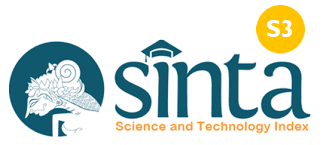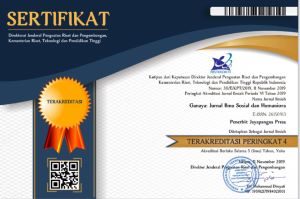Blended Learning During Pandemic: EFL Undergraduate Students’ Satisfaction
DOI:
https://doi.org/10.37329/cetta.v5i2.1700Keywords:
Blended Learning, English Education Students, SatisfactionAbstract
The objective of this research is to investigate the EFL students’ satisfaction on the implementation of blended learning at STKIP Agama Hindu Singaraja This research is a quantitative survey. The sample of this research was 76 undergraduate students of English education department STKIP Agama Hindu Singaraja. The data were gathered by using 5-point Likert scale questionnaire. The questionnaire validity and reliability checked and showed that the questionnaire was valid and had a high reliablity. The data were analysed by using quantitative with SPSS program. The findings showed that students were very saisfied toward the implementation of blended learning (M=4.03, SD=.759). In conclusion, blended learning could be implemented in today’s Covid-19 pandemic situation as it provides more opportunity for students to engage in learning process.
References
Agustino, L. (2020). Analisis Kebijakan Penanganan Wabah Covid-19 : Pengalaman Indonesia. Junal Borneo Administrator, 16(2), 253–270.
Aji, W. K., Ardin, H., & Arifin, M. A. (2020). Blended Learning During Pandemic Corona Virus: Teachers’ and Students’ Perceptions. IDEAS: Journal on English Language Teaching and Learning, Linguistics and Literature, 8(2), 632–646. https://doi.org/10.24256/ideas.v8i2.1696
Al-Qatawneh, S., Eltahir, M. E., & Alsalhi, N. R. (2019). The effect of blended learning on the achievement in a physics course of students of a dentistry college: A case study at ajman university. Education and Information Technologies, 19(1), 1–17. https://doi.org/10.34190/ejel.19.1.1992
Alaidarous, K., & Madini, A. A. (2016). Exploring EFL Students’ Perception in Blended Learning Environment in Saudi Technical Education Context. International Journal of Educational Investigations, 3(6), 69–81.
Almusharraf, N. M., & Khahro, S. H. (2020). Students’ Satisfaction with Online Learning Experiences during the COVID-19 Pandemic. International Journal of Emerging Technologies in Learning, 15(21), 246–267. https://doi.org/10.3991/ijet.v15i21.15647
Alsayed, F. (2020). The Effects of Semantics in the Language Development of English as a Foreign Language (EFL) Learners. International Journal of Learning and Development, 9(4), 138. https://doi.org/10.5296/ijld.v9i4.15735
Amri, A., Tebe, Y., Siantoro, A., Indrawati, M., & Prihadi, C. (2021). Teachers voices on school reopening in Indonesia during COVID-19 pandemic. Social Sciences & Humanities Open, 4(1), 100218. https://doi.org/10.1016/j.ssaho.2021.100218
Ary, D., Jacobs, L. C., Sorensen, C., & Razavieh, A. (2006). Introduction to Research in Education.
Espino-Díaz, L., Fernandez-Caminero, G., Hernandez-Lloret, C. M., Gonzalez-Gonzalez, H., & Alvarez-Castillo, J. L. (2020). Analyzing the impact of COVID-19 on education professionals. Toward a paradigm shift: ICT and neuroeducation as a binomial of action. Sustainability (Switzerland), 12(14), 1–10. https://doi.org/10.3390/su12145646
Fawaz, M., & Samaha, A. (2021). E-learning: Depression, anxiety, and stress symptomatology among Lebanese university students during COVID-19 quarantine. Nursing Forum, 56(1), 52–57. https://doi.org/10.1111/nuf.12521
Ginting, S., Tjandra, M., & Wianto, E. (2021). Blended Learning: Post Pandemic Solutions. Aksara: Jurnal Ilmu Pendidikan Nonformal, 7(2), 425. https://doi.org/10.37905/aksara.7.2.425-438.2021
Hutauruk, A. F., Gultom, S., & Nasution, A. A. B. (2021). Online Learning and Face-to-Face Learning in the COVID-19 Pandemic in SMA Erlangga Pematangsiantar. Budapest International Research and Critics Institute (BIRCI-Journal): Humanities and Social Sciences, 4(1), 1053–1058. https://doi.org/10.33258/birci.v4i1.1712
Ilahi, A. D. W., Rachma, V., Janastri, W., & Karyani, U. (2021). The Level of Anxiety of Students during the Covid-19 Pandemic. Proceding of Inter-Islamic University Conference on Psychology, 1(1), 1–6.
Islam, M. K., Sarker, M. F. H., & Islam, M. S. (2022). Promoting student-centred blended learning in higher education: A model. E-Learning and Digital Media, 19(1), 36–54. https://doi.org/10.1177/20427530211027721
Istiqomah, I. (2021). The Students’ Perceptions on Using Blended Learning for English Learning during Covid-19 Pandemic. Journal of English Language Teaching and Linguistics, 6(2), 307–317.
Iswati, L. (2021). When teaching must go on: ESP teachers’ strategies and challenges during COVID-19 Pandemic. Eralingua: Jurnal Pendidikan Bahasa Asing Dan Sastra, 5(1), 36. https://doi.org/10.26858/eralingua.v5i1.16196
Khaleyla, F., Wisanti, W., Ambarwati, R., Rahayu, D. A., & Putri, E. K. (2021). Software preference for online learning of science and biology teachers under COVID-19 pandemic. JPBI (Jurnal Pendidikan Biologi Indonesia), 7(1), 35–42. https://doi.org/10.22219/jpbi.v7i1.14253
Mahalli, Nurkamto, J., Mujiyanto, J., & Yuliasri, I. (2020). Students’ perception of blended learning implementation in EFL learning. International Journal of Innovation, Creativity and Change, 11(8), 161–172.
Mulyanti, B., Purnama, W., & Pawinanto, R. E. (2020). Distance learning in vocational high schools during the covid-19 pandemic in West Java province, Indonesia. Indonesian Journal of Science and Technology, 5(2), 271–282. https://doi.org/10.17509/ijost.v5i2.24640
Nijakowski, K., Lehmann, A., Zdrojewski, J., Nowak, M., & Surdacka, A. (2021). The effectiveness of the blended learning in conservative dentistry with endodontics on the basis of the survey among 4th-year students during the covid-19 pandemic. International Journal of Environmental Research and Public Health, 18(9). https://doi.org/10.3390/ijerph18094555
Noour, M. A. T., & Hubbard, N. (2015). Self-Determination Theory: Opportunities and Challenges for Blended e-Learning in Motivating Egyptian Learners. Procedia - Social and Behavioral Sciences, 182, 513–521. https://doi.org/10.1016/j.sbspro.2015.04.836
Ntim, S., Opoku-Manu, M., & Addai-Amoah Kwarteng, A. (2021). Post COVID-19 and the Potential of Blended Learning in Higher Institutions: Exploring Students and Lecturers Perspectives on Learning Outcomes in Blended Learning. European Journal of Education and Pedagogy, 2(6), 49–59. https://doi.org/10.24018/ejedu.2021.2.6.162
Putra, K. D. P., & Wulandari, I. (2021). Teacher’s Perceptions of Online Learning Activities During The Covid-19 Pandemic. Jurnal Ilmiah Sekolah Dasar, 5(1), 110–118.
Rachman, L. A., Sudiyono, S., & Phonix, E. (2021). The Blended Learning Implementation of ELT Based on Teachers and Students’ Perspective in New Normal Condition of Covid 19. PROJECT (Professional Journal of English Education), 4(3), 457. https://doi.org/10.22460/project.v4i3.p457-468
Rasheed, R. A., Kamsin, A., & Abdullah, N. A. (2020). Challenges in the online component of blended learning: A systematic review. Computers and Education, 144(March 2019), 103701. https://doi.org/10.1016/j.compedu.2019.103701
Saminathan, V. (2020). Problems of Online Classes. International Journal of Academic Research Reflectoor, 9(6), 1–3. https://doi.org/10.6084/m9.figshare.13573550
Sefriani, R., Sepriana, R., Wijaya, I., Radyuli, P., & Menrisal. (2021). Blended learning with edmodo: The effectiveness of statistical learning during the covid-19 pandemic. International Journal of Evaluation and Research in Education, 10(1), 293–299. https://doi.org/10.11591/IJERE.V10I1.20826
Simbolon, N. E. (2021). EFL students’ perceptions of blended learning in English language course: learning experience and engagement. Journal on English as a Foreign Language, 11(1), 152–174. https://doi.org/10.23971/jefl.v11i1.2518
Ughanda, P., & Badre, S. (2020). Blended Learning - a Study on Student’s Perception About. The Online Journal of Distance Education and E-Learning, 8(2), 72–79.
Watrianthos, R. (2019). Jurnal Pendidikan MIPA. Jurnal Pendidikan MIPA, 20(1), 23–29.
Downloads
Published
How to Cite
Issue
Section
License
Copyright (c) 2022 Ni Wayan Tasya Astri Prawisanthi, I Gede Yoga Permana

This work is licensed under a Creative Commons Attribution-ShareAlike 4.0 International License.
An author who publishes in the Cetta : Jurnal Ilmu Pendidikan agrees to the following terms:
- Author retains the copyright and grants the journal the right of first publication of the work simultaneously licensed under the Creative Commons Attribution-ShareAlike 4.0 License that allows others to share the work with an acknowledgement of the work's authorship and initial publication in this journal
- Author is able to enter into separate, additional contractual arrangements for the non-exclusive distribution of the journal's published version of the work (e.g., post it to an institutional repository or publish it in a book) with the acknowledgement of its initial publication in this journal.
- Author is permitted and encouraged to post his/her work online (e.g., in institutional repositories or on their website) prior to and during the submission process, as it can lead to productive exchanges, as well as earlier and greater citation of the published work (See The Effect of Open Access).
Read more about the Creative Commons Attribution-ShareAlike 4.0 Licence here: https://creativecommons.org/licenses/by-sa/4.0/.





